A Worldwide Shipping Empire
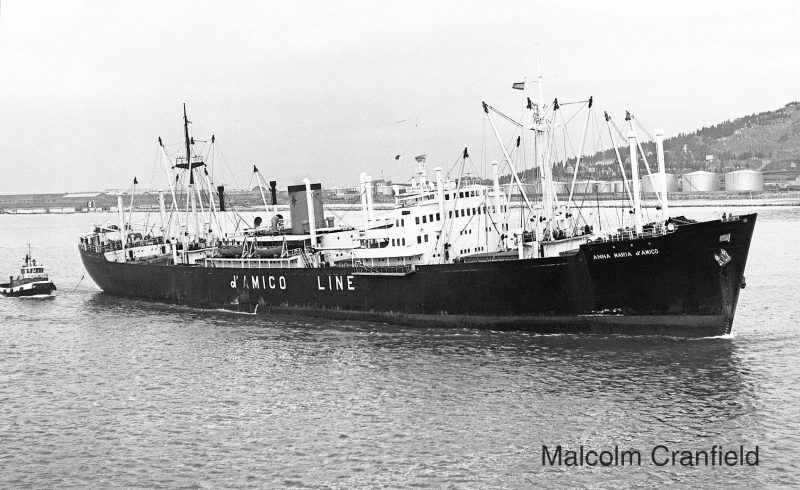
This is the remarkable story of a large family of seven brothers from Salerno on the Amalfi coast, who turned a small timber trading business in 1936 into a multinational shipping group. Today, eighty years later, one hundred Panamax, Kamsarmax, Supramax and Handymax bulkers, and Aframax and Suezmax tankers are owned or chartered. The brothers were Giuseppe (the eldest and known as ‘Peppino’ in the family), Oronzo, Vittorio, Carlo, Massimino Ciro, Salvatore and Antonio d’Amico, all born in the 1910s and 1920s decades. Giuseppe d’Amico with his father Massimiro Ciro d’Amico sought to improve the family timber business by importing their supplies of timber and logs by sea from the Balkans in small schooners and auxiliary powered twin masted sailing barges of up to 120 feet in length. Almost all, except two, became war losses during World War II, after Allied troops had slowly moved up the Italian peninsula from landings in Sicily in July 1943 and two months later at Salerno into Northern Italy.
The sailing vessel losses were replaced in 1945/46 by three small wooden auxiliary powered engines aft coasters of lengths between 120 and 130 feet. These were built by yards at Viareggio as Massimino Ciro 388/46, the twin masted Sette Fratelli (Seven Brothers) of 300 grt launched in 1943 and completed in December 1945, and Maria Cristina 371/46. The trio all had beams of 28 feet and were ideal for transporting small timber cargoes from the Italian ports of Venice and Genoa, powered by Ansaldo diesels of either four cylinder or seven cylinder varieties. During 1947/49, two sister engines ‘midships twin masted motor cargo ships of 3,000 dwt joined the fleet in the owned Francesca, completed at the Breda yard near Venice in 1944, and the managed Annamaria from the same yard and powered by five cylinder Tosi diesel engines. Annamaria was managed for Comeda of Italy (Compania Mediterranea d’Armamento), in which the d’Amico brothers later took a 20% interest and today is an associated company. The surplus standard ‘Jeep’ type Samuel F. Dewing was purchased from America and renamed Maria Carla, and these three short-sea vessels were employed on a regular service linking Italy with Turkey, Syria, Lebanon and Egypt.
In 1948, the decision was made by the brothers to move into deep-sea shipowning by purchasing some of the surplus ‘Liberty’ dry cargo and ‘T2’ tankers from America, helped by the Marshall Plan. The ‘Liberty’ types Harvey Cushing and Edward P. Alexander were renamed Eretteo and Orizia respectively, and the ‘T2’ Quebec was renamed Maria Cristina D. More surplus standard vessels were purchased or managed over the next four years, including Alcione (ex Fort Gibraltar), Atlanta (ex Fort Simpson), Ariella (ex Mohawk Park but purchased from Buries Markes as La Orilla), Citta di Salerno (ex ‘Liberty’ Samaffric but purchased from Ben Line as Benvrackie), Paestum (ex ‘Liberty’ Samspeed), and Marialaura (ex Empire Eddystone).
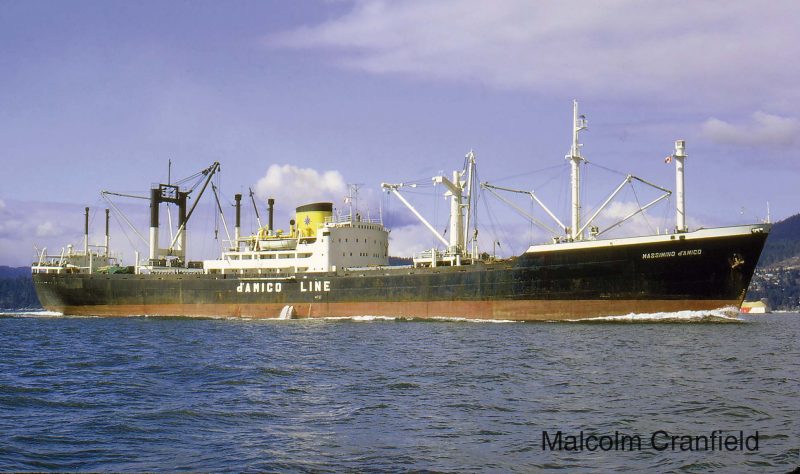
The Braathen tanker Braconda of 15,963 dwt and completed in 1940 was purchased in October 1950 by the d’Amico brothers, now with an office in Rome, and renamed Linda Giovanna. Further second hand tankers were purchased in 1951 in O.B. Sorensen of 12,500 dwt from Smith Sorensen Tankrederei of Arendal, completed by Kockums of Malmo in 1931 and renamed Viking, Noravind of 12,500 dwt completed in 1930 by the Gotaverken yard as Nordanvik for Norrkopings Rederi A/B and later renamed Normanna in 1957 by the d’Amico brothers, Fosna of 12,500 dwt, completed in 1930 by the Gotaverken yard although the hull was built by the Caledon yard at Dundee, and renamed Marinella. The surplus ‘T2’ type Fallen Timbers was purchased in 1952 and renamed Massiminociro D, in a momentous year in which the seven brothers were to split and go their separate ways.
Splitting Of The Family Interests
In 1952, Giuseppe d’Amico and his brothers Oronzo, Vittorio and Carlo remained with Fratelli d’Amico Armatori based in Rome, whereas Massimino Ciro d’Amico and his brothers Salvatore and Antonio broke away and founded a rival shipping company D’Amico Societa di Navigazione based in Palermo in Sicily. Giuseppe d’Amico had been born in 1913 and was always considered a far sighted shipowner, and this also extended to the needs of the Italian telecommunications industry. He urged the building of the twin screw cablelayer Salernum of 2,834 grt and launched in 1953 and completed in 1956 by the Navalmeccanica Castellamare di Stabia yard near Naples for Compania Italiana Navi Cablografiche. She was chartered to the Italian Government P.T.T. and Italcable as required for cablelaying and hydrographic and oceanographic research, and managed by Fratelli d’Amico.
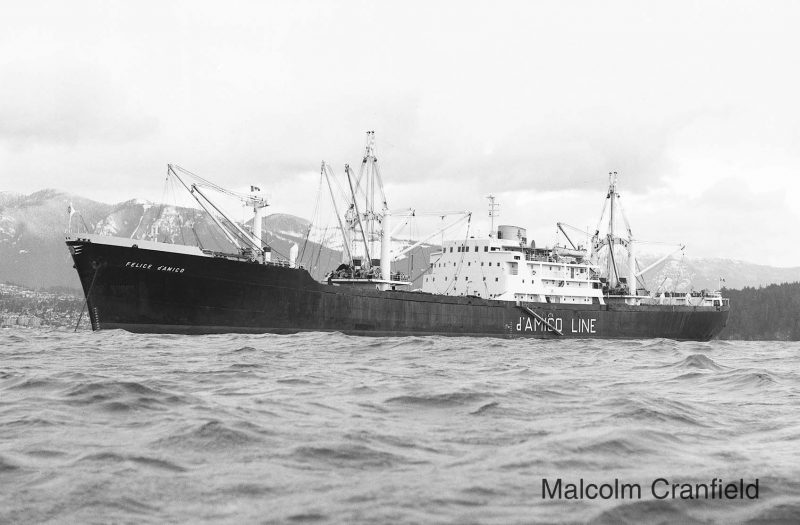
The d’Amico brothers combined fleet at the start of 1952 had stood at eighteen vessels, and by 1960 the two separate fleets comprised fourteen vessels under Fratelli d’Amico Armatori, and eight vessels under Soc. d’Amico di Navigazione spA. These included four supertankers of 32,000 dwt, all completed in 1954 by yards at Trieste, Monfalcone and Livorno, with two for Fratelli d’Amico Armatori as Mare Adriacum and Mare Nostrum, and two for D’Amico Soc. di Navigazione as Mina d’Amico and Mirella d’Amico. The quartet were powered by steam turbines supplied by General Electric Corporation of New York, with service speeds of seventeen knots. The two rival fleets in 1960 owned or managed:-
Fratelli D’Amico Armatori
Seven tankers – Mare Adriacum, Mare Nostrum, Elisabetta D, Maria Cristina D, Massiminociro D, Normanna (although laid up at Naples from March 1958), and Viking, all trading on charter to oil majors.
Six dry cargo vessels – Alcione, Ariella, Asteropes (ex Empire Takoradi in 1956), Atlanta, Eretteo, and Marialaura engaged on worldwide time and voyage charters. One cablelayer – Salernum.
They had yellow funnels with a blue Maltese Cross bearing a white centre and a red top, later changed to a black top with a red band immediately below.
Societa D’Amico Di Navigazione
Four dry cargo vessels – Sisters Cesare d’Amico and Paolo d’Amico of 8,835 grt and 12,510 dwt built at Taranto in 1957, and ‘Liberty’ types Citta di Salerno and Paestum, trading on voyage or time charter to Caribbean ports.
Six tankers – Supertankers Mina d’Amico and Mirella d’Amico, and supertanker Cristina d’Amico of 32,000 dwt completed in 1960 at La Spezia, and sisters Giovannella d’Amico and Marinella d’Amico of 19,320 dwt completed at Venice, and Marinella. All six were on long term charter to oil majors, with Giovannella d’Amico on charter to a chemical company with the suffix ‘Chemist’ added to her name.
They had yellow funnels with a blue eight pointed star and a red top, later changed to a blue top.
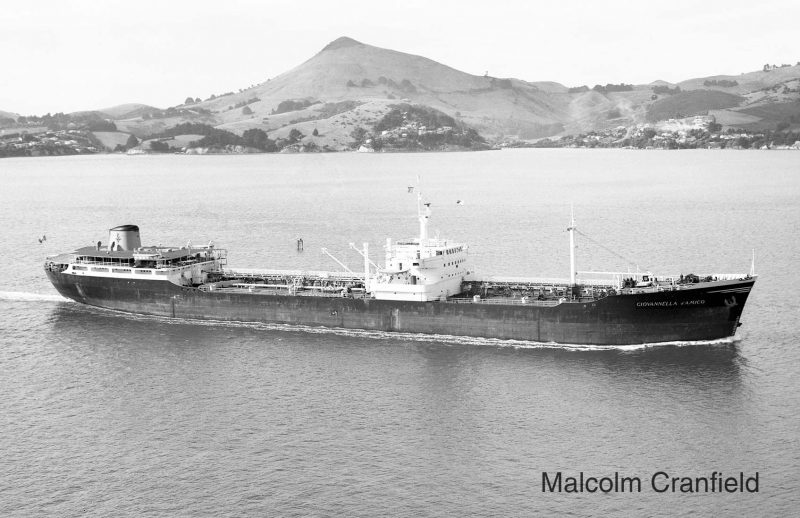
Marinella was sold to Italian shipbreakers in August 1960, the laid up Normanna was towed from Naples to Trieste for breaking up in June 1962, Viking arrived at La Spezia for breaking up on 9th April 1963 and demolition took only two months. Marialaura (ex Empire Eddystone) was broken up at Trieste in May 1966, and Asteropes (ex Empire Takoradi) had arrived at La Spezia on 2nd November 1964. The fleet received two motor tankers of 19,000 dwt in 1967 in Sofia d’Amico (ex Grena of J. Ludwig Mowinckels) built in 1958 at the Bremer Vulkan yard at Vegesack, and Elena d’Amico (ex Frisco of Societa Petroltankers di Navigazione) built in 1954 at the Ansaldo yard in La Spezia.
The ‘Liberty’ type Erreteo grounded on Sakhalin Island on 20th September 1965 while on a voyage from Tanoura (Japan) to Vancouver, and broke in two twelve days later in a typhoon. A marine loss later occurred on 11th June 1966 when the ‘Liberty’ type Paestum sank off Cape Hatteras while on a voyage from Boca Grande (Florida) to Catania with phosphates. She had earlier in the month put into Charleston with leaks in number two hold, and sailed for Norfolk (Va) for repairs, but was abandoned the day before she sank with flooding in her holds and engine room.
The next generation of the family, Cesare d’Amico and Paolo d’Amico, were managing the Societa d’Amico di Navigazione in the late 1960s alongside Massimino Ciro d’Amico, Salvatore d’Amico and Antonio d’Amico. Fratelli d’Amico Armatori was managed by the partners Giuseppe d’Amico and Oronzo d’Amico with a big fleet of eighteen vessels with ‘Mare’ as a prefix to their names. The same number of vessels was being managed by the rival d’Amico company, whose fleets in 1974 comprised:-
Fratelli D’Amico Armatori
Eight reefers – Mare Antartico, Mare Arabico, Mare Artico, Mare Australe, Mare Boreale, Mare Caribico, Mare Italico and Mare Somalo. They had four holds and high service speeds of twenty knots and were built by the Ansaldo yards at Genoa and La Spezia.
Eight bulkers – Mare Dorico, Mare Felice, Mare Ligure, Mare Piceno, Mare Placido, Mare Sereno, Mare Tirreno and Mare Tranquillo ranging from 25,000 dwt to 80,000 dwt. They were geared bulkers with usually derricks on five pairs of kingposts.
One bulk/oil – Mare Aegeum of 87,875 dwt.
One tanker – Mare Adriacum of 33,800 dwt.
One cablelayer – Salernum
Societa D’Amico Di Navigazione
Nine dry cargo vessels – Anna Maria d’Amico (ex Hoegh Silverstream of 1948 purchased in 1967), Giovanni d’Amico (ex Ferndale of 1948 purchased in 1967), Lorenzo d’Amico (ex Soestdyk of Holland America Line of 1948 purchased in 1970), Maria Carla d’Amico (ex Fernside of 1948 purchased in 1967), Massimino d’Amico (ex Fernfield of 1948 purchased in 1967), Cesare d’Amico of 1957, Paolo d’Amico of 1957, Felice d’Amico (ex Tidecrest of 1958) and Luigi d’Amico (ex Orient Mariner of 1964 purchased in 1969). They were employed on an Italian and Mediterranean ports service to West Coast U.S.A. and Canadian ports via the Caribbean and the Panama Canal.
Eight tankers – Cielo Azzurro, Cielo Rosso, Cristina d’Amico, Elena d’Amico, Giovannella d’Amico, Linda Giovanna, Marinella d’Amico and Sofia d’Amico, all around 20,000 dwt.
One bulk/oil – Cielo Bianco of 87,365 dwt.
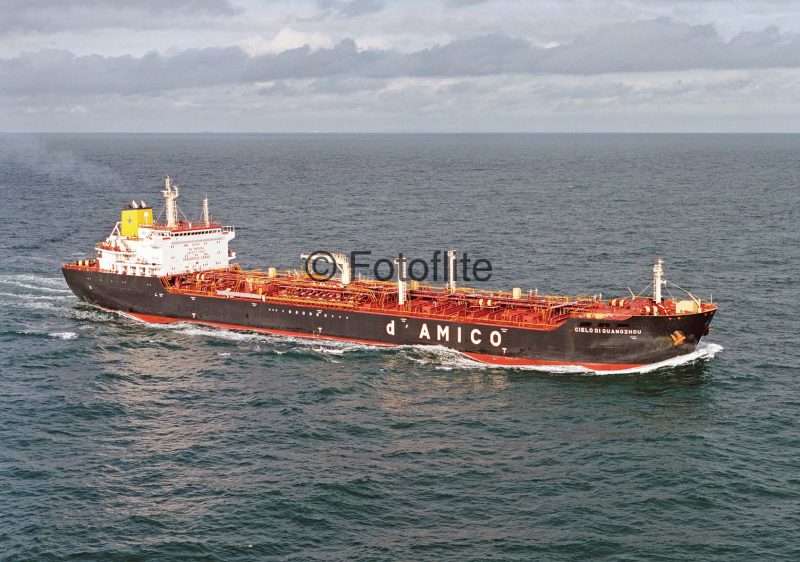
Opec Crisis And Reduction In Fleet Size
The oil price hike in November 1973 by the OPEC oil production countries caused an immediate surplus of 20% of tanker capacity, as demand declined on such high prices for oil, and consumers switched to gas, electricity and other forms of energy. The world tanker market stayed in heavy overcapacity, with half or more of all tankers considered surplus to requirements for a decade until 1985 before eventually easing in the early 1990s. The rival d’Amico companies scrapped several tankers, including Elena d’Amico in 1974, Linda Giovanna in Italy in May 1976, and Sofia d’Amico in 1976. Giovannella d’Amico was beached at Gadani Beach for breaking up on 21st July 1981, and her sister Marinella d’Amico was sold at the same time for further trading and renamed Nunki.
The West Coast U.S.A. and Canada service from Italian and Mediterranean ports was reduced from nine break bulk cargo vessels in 1974 to only two in 1980, Massimino d’Amico and Luigi d’Amico. The former vessel had been built in 1948 by the Ansaldo yard at Monfalcone as Fernfield for Fearnley & Eger of Oslo, and was one of three sister ships purchased by Societa d’Amico di Navigazione in 1967. She lasted the longest of this trio, until she sailed from Genoa on 24th April 1980 bound for the scrapyards of Kaohsiung. Luigi d’Amico, the former Orient Mariner built in 1964, traded on the Pacific West Coast service for another four years until sold to Maltese owners for further service under the name of Captain. The d’Amico service to Pacific ports began to use container/bulker vessels from 1979, such as Cielo di Amalfi, Cielo di Genova and Cielo di Vancouver of 33,000 dwt with capacity for 1,150 TEU of containers to provide a better forestry products and container service for shippers. The large bulk/ore carrier Cielo Bianco was sold off in 1983, and the two rival d’Amico fleets had begun to recover by 1985, comprising:-
Fratelli D’Amico Armatori
Seven reefers – Mare Antartico, Mare Arabico, Mare Artico, Mare Australe, Mare Boreale, Mare Italico and Mare Somalo.
Six bulkers – Mare Felice, Mare Piceno, Mare Placido, Mare Sereno, Mare Tirreno, Mare Tranquillo, ranging in size from 25,000 dwt to 80,000 dwt.
One bulk/oil carrier – Mare Aegeum of 87,875 dwt.
Societa D’Amico Di Navigazione
Three tankers – Cielo Azzurro, Cielo Rosso, Cristina d’Amico.
Three general cargo ships – Cesare d’Amico, Paolo d’Amico and Cielo di Livorno.
Two container/bulkers – Cielo di Genova, Cielo di Venezia (ex Arctic Troll).
Fleet Expansion In The 1990s Decade
Guiseppe D’Amico, the Chief Executive of Fratelli d’Amico Armatori, was quick to grasp the opportunities in the early 1990s of a better tanker freight market. He acquired the first new double hull Aframax tanker Mare Dorico of 85,000 dwt when completed in March 1993 at the Ancona yard of Fincantieri. She had been launched as Marea for the State owned Finmare Group, and two further sisters of this size were taken on charter from Finaval Spa of Rome as Scorpius and Leonis in 1994 and were later purchased.
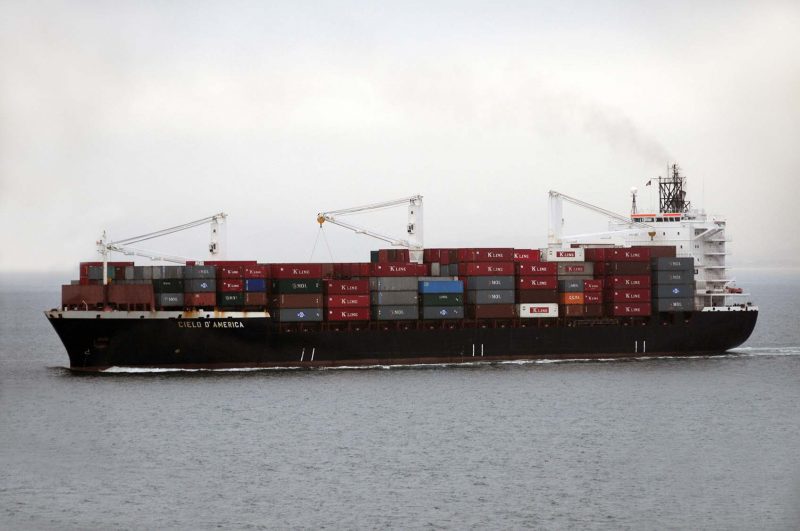
The regular container/bulker service of Societa d’Amico di Navigazione to Pacific West coast ports was operated at the end of 1990 in a pool of fourteen international shipping companies. Maersk Line, Nedlloyd, P. & O. Containers, Sea-Land, Zim Line, CGM, Lykes Line, Trasatlantica, Costa Line, Evergreen, Italia Line, Yugolinija and Farrell Line were all competing for a share of the available trade. On 7th August 1998, the Italian State owned Finmare completed the privatisation of its container interests of Italia Line to D’Amico International, the Luxembourg based arm of Societa d’Amico di Navigazione. Four vessels passed from Italia Line to d’Amico ownership in California of 23,724 dwt and 1,058 TEU capacity built in 1989, container ship sisters Cristoforo Colombo and Amerigo Vespucci of 2,232 TEU capacity built in 1989, and S. Caboto of 15,000 dwt and 1,062 TEU capacity built in 1991. The new sister container ships Cielo d’America and Cielo d’Italia were added in 1999 of 30,360 dwt and 2,064 TEU capacity, to give enlarged fleets of the two rival d’Amico companies at the Millennium:-
Fratelli D’Amico Armatori
Four tankers – Mare Dorico, Mare Oriens, Scorpius, Leonis.
Two Supramax bulkers – Mare Baltico, Mare Vikingo.
Societa D’Amico Di Navigazione
Seven tankers – Cielo di Milano, Cielo di Roma, Cielo di Salerno, Cielo di Singapore, Cielo di Parma, High Challenge, High Spirit, High Wind, Highseas, Hightide with many others chartered or managed e.g. High Rod Falk and High Svart Falk.
Four container ships – Cielo d’America, Cielo d’Italia, Cristoforo Colombo, Amerigo Vespucci.
Four con/bulkers – Cielo d’Europa, Cielo di Genova, California, S. Caboto with a further dozen vessels chartered or managed.
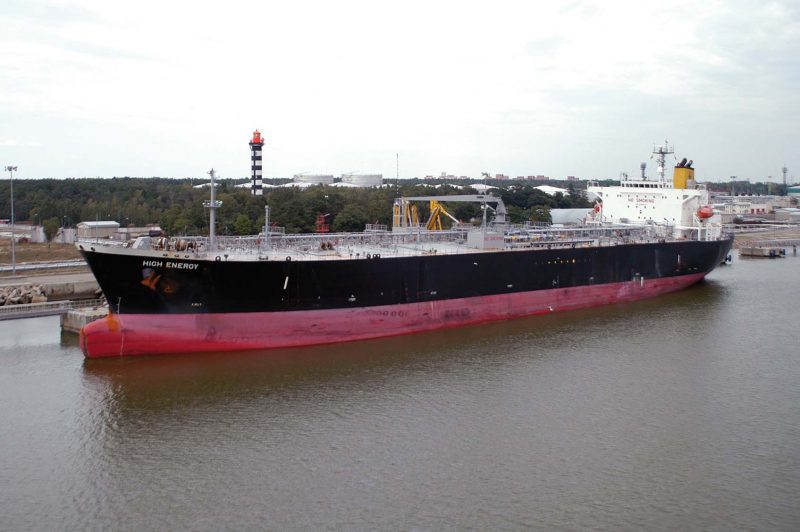
Refocus Of Societa D’Amico Di Navigazione
Antonio d’Amico, the Chairman and co-founder of Societa d’Amico di Navigazione, died in September 2002 aged 79 years. He had broken away in 1952 from Fratelli d’Amico Armatori with his brothers Massimino Ciro and Salvatore, and became Managing Director of Societa d’Amico di Navigazione in 1966. He had spent several years in New York before returning to Italy to work on the dry cargo and tanker businesses of the company. Cousins Cesare d’Amico and Paolo d’Amico had long been in charge of the day to day operations of the company, and they then decided to refocus on bulkers and tankers as they were not prepared to spread themselves too thinly over the three industry sectors of container ships, bulkers and tankers. Paolo d’Amico was also President of Confitarm, the Italian Shipowners Association, and he began to plan to significantly expand the dry bulk and double hull tanker fleets. Accordingly, the container ships were put up for sale in July 2002, and a month later four trade routes and nine container ships and con/bulkers were sold to CP Ships for $40 million. Cristoforo Colombo, Amerigo Vespucci and S. Caboto were later sold on to Greek owners by 2004, with another pair of ships sold to Ignazio Messina in February 2003.
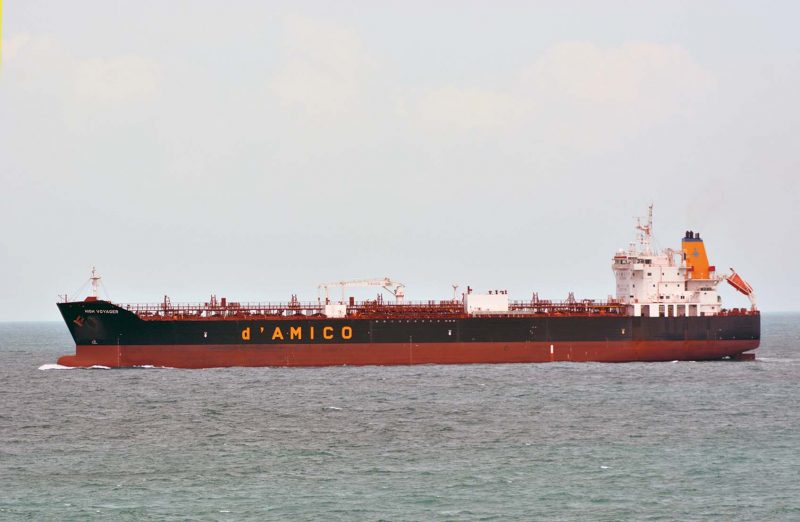
D’Amico Dry was set up in Dublin later in 2002 with chartering activities in Monaco, Singapore, Vancouver and Stamford (U.S.A.). A large fleet of Handysize bulkers in the range 37,000 to 39,000 dwt, Supramax bulkers in the range 53,000 to 60,000 dwt, Panamax and Kamsarmax bulkers in the range 74,000 to 82,000 dwt has since been built up. D’Amico Tankers Ltd. was also set up in Dublin in 2001, and delivery was then taken of a further five product tankers, three of which were long term bareboat chartered from the d’Amato Group of Naples as Fabrizia d’Amato, Rita d’Amato and Umberto d’Amato. Five former Maersk ‘R’ class product/chemical tankers of 27,350 dwt were acquired second hand over a two year period from September 2004 in Cielo di Biscaglia, Cielo del Baltico, Cielo di Bothnia, Cielo di Baffin and Cielo di Barents and were sold on at the end of 2006 at a good profit of $30M, with management retained for some of them.
A large fleet of Handysize (36,000-40,000 dwt) and Medium Range (MR) (45,000-51,000 dwt) tankers has since been built up from Chinese and Japanese shipyards with long term credit facilities from Italian banks. The present size of these bulker and tanker fleets are:-
D’Amico Dry
Two dozen Handysize – Cielo di Taranto, Cielo di Dublino, Cielo di Genova, Cielo di Livorno, Cielo di San Francisco, Cielo di Vaiano, Cielo di Capalbio, Cielo di Monfalcone, Cielo di Vancouver, Cielo di Monaco, Cielo di Spezia, Cielo di Tocopilla, Cielo de Virgin Gorda, Cielo di Valparaiso, Cielo di Amalfi, Cielo di Venezia, Cielo di Tokyo, Cielo di Pisa, Cielo di Palermo, Cielo di Cartagena, Cielo di Angra, Cielo di Tampa, Cielo di Jari and Cielo di Panama.
Two dozen Supramax – Medi Nagasaki, Medi Lisbon, Medi Bangkok, Medi Valencia, Medi Imabari, Medi Firenze, Medi Paestum, Medi Segesta, Medi Okinawa, Medi Yokohama, Medi Manila, Medi Hakata, Medi Huangpu, Medi Zhoushan, Medi Cork, Medi Mumbai, Medi Zuoz, Medi Roma, Medi Kyoto, Medi Brisbane, Medi Norfolk, Medi Perth, Medi Astoria and Medi Portland.
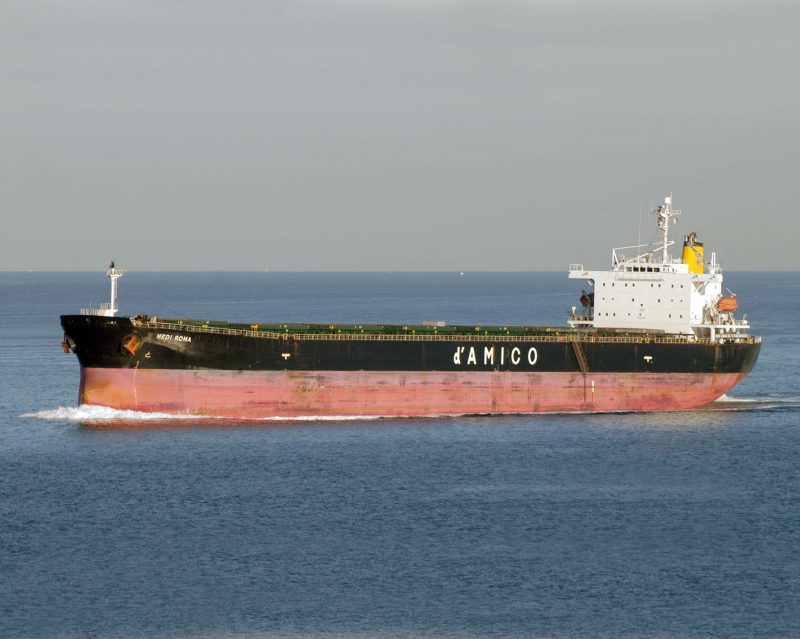
Twelve Panamax and Kamsarmax – Medi Tokyo, Medi Cagliari, Medi Vitoria, Medi Venezia, Medi Baltimore, Medi Lausanne, Medi Hong Kong, Medi Genova, Medi Antwerp, Medi Salerno, Medi Matsuura and Medi Sydney.
Two Mini Capesize – Cielo d’Italia and Cielo d’Europa of 116,000 dwt. Flagships of the fleet.
D’Amico Tankers
Seven Handysize – Cielo di Milano, Cielo di Roma, Cielo di Londra, Cielo di Parigi, Cielo di Salerno, Cielo di Napoli, Cielo di Guangzhou.
Thirty Five Medium Range (MR) – High Beam, High Challenge, High Courage, High Current, High Discovery, High Efficiency, High Endeavour, High Endurance, High Enterprise, High Fidelity, High Freedom, High Force, High Glow, High Jupiter, High Loyalty, High Mars, High Mercury, High Pearl, High Power, High Performance, High Progress, High Prosperity, High Presence, High Priority, High Saturn, High Seas, High Sprit, High Sun, High Strength, High Tide, High Volume, High Valor, High Venture, High Voyager, and High Wind. In addition, around thirty product tankers are chartered in at any one time.
Four Long Range (LR) tankers of 75,000 dwt under construction for delivery in 2017 by the Hyundai Mipo yard.
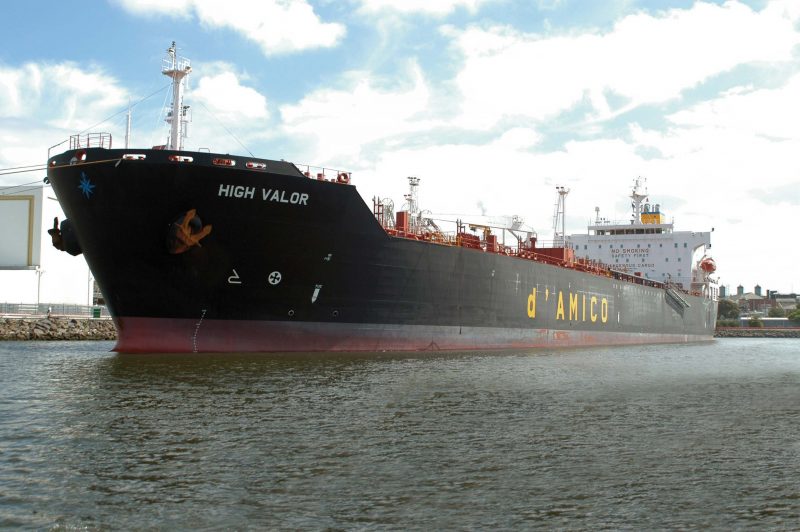
Joint ventures (50/50) were set up with the Glencore Group as Glenda International Shipping for five Handysize tankers Glenda Melanie, Glenda Melissa, Glenda Melody, Glenda Meryl and Glenda Meredith, and with Librero Panama S.A. for one Handysize tanker named Pacific Marchioness, and also with Ishima (Pte) Ltd. of Singapore, Mitsubishi and Mitsui of Japan, and other Italian and international shipping companies e.g. D’ACC Maritime Ltd., a joint venture with Coeclerici of Genoa.
The D’Amico Liner Service to the Pacific coast terminals of Lynnterm, Fibreco and Harmac operates monthly to eight Italian ports with forestry products and timber parcels. In May 2011, a new service began from West Coast Canadian ports to Chinese ports with forestry products using the new bulker Cielo di San Francisco. Two feeder container ships, Cielo di Agadir (1,120 TEU) and Cielo di Casablanca (950 TEU) operate under the Moroccan flag linking Tangier Med to Casablanca to continue a d’Amico liner service from Italy to Morocco that began in 1970.
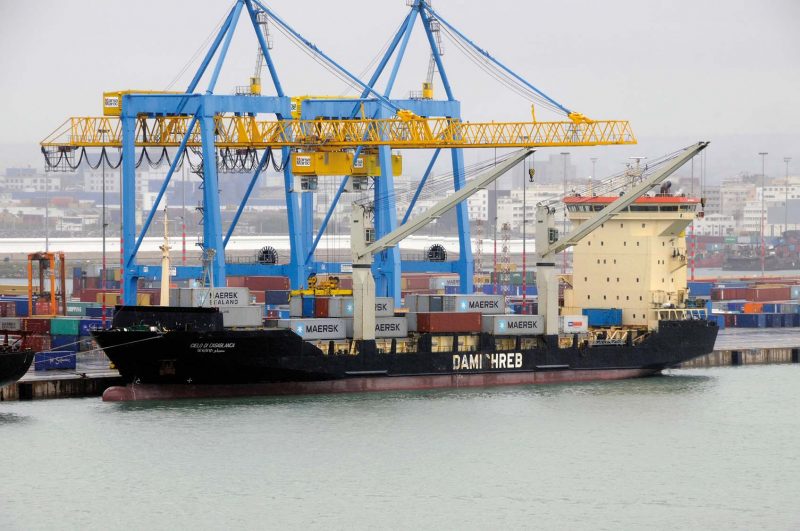
Fratelli D’Amico Armatori
Giuseppe d’Amico, Chairman and co-founder of the company along with three of his brothers, died in October 2010 at the age of 97 years. He was the eldest of the seven brothers and also had the longest lifespan. He was known in the family as ‘Peppino’, and was still active in the company up to his death, ordering seven modern Aframax tankers from Mitsui yards in Japan and four double hull Suezmax tankers from the Samsung yard in South Korea between 2003 and his death in 2010. A fleet of twelve tankers was traded in 2012, comprising:-
Eight Aframax tankers – Mare Adriacum, Mare Aegeum, Mare Italicum, Mare Nostrum, Mare Oriens, Mare Tirrenum, Leonis and Scorpius
Four Suezmax tankers – Mare Doricum, Mare Picenum, Mare Siculum, and one under construction for delivery in 2012.
Postscript
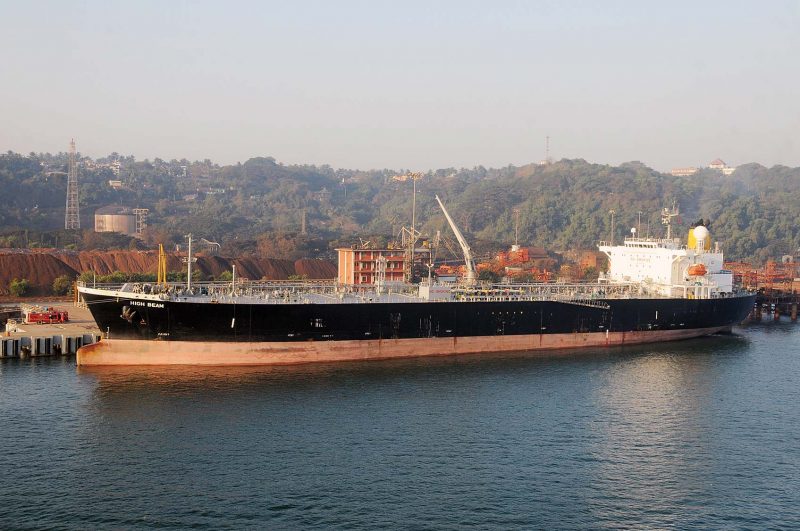

The next generation of the d’Amico family are today in active roles to expand their shipping activities, including Antonia d’Amico, Carlos d’Amico, Emanuele d’Amico, Lorenzo d’Amico and Salvatore d’Amico. The Societa d’Amico di Navigazione fleet has grown to over one hundred owned or chartered bulkers and tankers, employing six hundred shore based staff and one thousand seafarers. Twenty tanker newbuildings are on order, with the company controlled from offices in Rome, Milan, Cagliari, Dublin, Monaco, London, Luxembourg, Singapore, Stamford (U.S.A.), Vancouver and Mumbai.
The black hulls of both the tanker and bulker fleets have prominent white letters of ‘d’AMICO’ on both sides of their hulls, with the Handysize bulker fleet operating worldwide and the Supramax bulker fleet increasing their share of Japanese and Asian cargoes by joint ventures with Mitsubishi and Mitsui. The Medi Supra Pool Management based in Singapore began operations in March 2015 to find employment for their fleet of twenty five Supramaxes. Teesside in the U.K. has seen many d’Amico tankers and bulkers over a long period of fifty years, with export cargoes of oil and potash, and imports of rutile sand (titanium oxide) for the Huntsman Titanium plant. I wish to thank the excellent websites of Fratelli d’Amico Armatori at www.damicofratelli.it and of Societa d’Amico di Navigazione at www.damicoship.com.
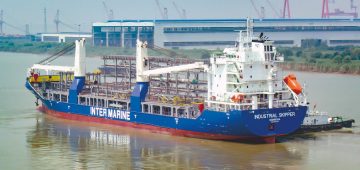
Comments
Sorry, comments are closed for this item